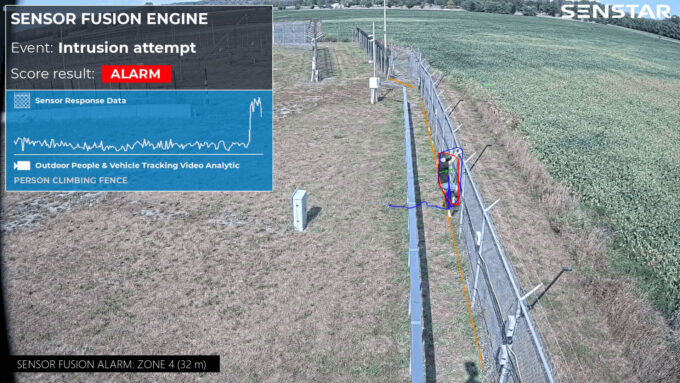Six Challenges in Securing Large Perimeters: Part 1

A recent article posted on securitymagazine.com summarized six challenges associated with securing the perimeters of large facilities. In Part 1 of this article, we examine the first three challenges in greater depth and look at how Senstar provides best-in-class solutions that, as securitymagazine.com puts it, serve as part of a holistic approach that integrates technology, personnel and processes to ensure a robust and effective security strategy.
Scale and Complexity
Challenge 1: “Managing and monitoring a vast and complex perimeter can be overwhelming. Coordinating security measures across large areas requires comprehensive planning and robust resources.”
A properly designed perimeter security solution acts as a force multiplier, freeing up human resources instead of consuming them. To ensure the overall physical protection system (PPS) meets the facility’s requirements, system designers and integrators need to select security technology that provides facility operators with the critical information they need to maintain situational awareness:
- Senstar offers security solutions designed to protect the perimeters of very large facilities, including petrochemical refineries, power generation facilities, airports, space launch facilities, military bases, and correctional facilities.
- To manage complexity, Senstar sensors share a common communications framework and report precise intrusion information to centralized security operations centers. A comprehensive portfolio includes fully integrated solutions for fences, walls, entrance gates, and access control devices.
- When Senstar sensors are combined with the Senstar Symphony Common Operating Platform, the intrusion locations are graphically displayed on facility maps and can be used to automatically call up specific video surveillance feeds or trigger specific actions. A unified interface simplifies training requirements and empowers operators with the tools they need to respond to a range of threats.

The Senstar Symphony Common Operating Platform reduces complexity by providing the operator with unified interface for security, video, access control, and device management
Resource Allocation
Challenge 2: “Assigning adequate personnel and technology resources to cover an extensive perimeter can be resource intensive. Effective surveillance, patrols and response mechanisms must be established to deter and/or address potential security breaches promptly.”
Perimeter intrusion detection technology frees up personnel by letting them do what they do best – providing human insight to unfolding situations and responding to threats. Intrusion detection alarms generated by comprehensive, defense-in-depth solutions direct operator attention to critical events and assist in helping them to coordinate the deployment of appropriate countermeasures and response forces.
- Instead of requiring multiple people to passively observe screens for suspicious events (a function that research confirms is challenging for humans), individual operators can monitor larger areas, freeing up human resources for other activities.
- To reduce operator distractions, Senstar sensors are designed to minimize nuisance alarms. Field-tested and proven, our sensors include environmental disaggregation as well as AI-based sensor fusion
- Maintenance staff can use data obtained from sensors to quickly locate damaged or loose fence fabric, reducing the frequency and time requirements of physical inspections.

Senstar technologies like its Sensor Fusion Engine reduce the resources required to monitor large perimeters by defeating nuisance alarms once and for all.
Limited surveillance coverage
Challenge 3: “Achieving consistent surveillance coverage across every inch of an expansive perimeter can be difficult. Blind spots may emerge due to terrain, equipment, lighting, structures or other obstacles, offering potential entry points for intruders.”
Vulnerabilities like blind spots or line-of-sight (LOS) issues are a challenge for facilities of all sizes but especially large ones. Physical realities may make it unfeasible or cost-prohibitive for complete, high-quality surveillance coverage. Similar concerns apply to LOS sensors like ground-based radar or LIDAR. Fortunately, for this specific deployment challenge, Senstar fence-mounted and buried perimeter intrusion detection sensors reveal one of their major strengths: detection coverage of the entire facility, with no coverage gaps that an intruder can exploit to get inside undetected.
Senstar also offers solutions that help to improve the deployment and capabilities of the surveillance cameras themselves:
- Perimeter lighting: The Senstar LM100 provides a 2-in-1 perimeter illumination and intrusion detection solution. Low-power, uniform fence line illumination with a high color rending index (CRI) value improves the assessment capabilities of surveillance cameras, ensuring high quality nighttime visibility without hotspots.
- Secure networking: When fiber sensors are deployed along the perimeter, unused fibers may be repurposed for use by network cameras, avoiding the need to run additional networking cables and thereby reducing overall installation costs while maintaining a higher level of security over that of copper-based Ethernet cabling.

Combining two key security functions in one cutting-edge product, the Senstar LM100 acts as a powerful deterrent against intruders, detecting and illuminating them at the fence line while alerting the site’s security system. Unform, high CRI value lighting without hotspots maximizes the assessment capabilities of the site’s video surveillance system.
Coming Up Next: Part 2
In our next Security Digest post, we will cover the remaining 3 challenges.
For More Information
Senstar has been securing critical infrastructure and facilities for over 40 years. The depth and breadth of our institutional knowledge, reflected in our comprehensive portfolio and innovative technologies, enables us to offer solutions that solve the security challenges faced at large facilities. For information on our Senstar can help secure your facility, contact your local representative.

